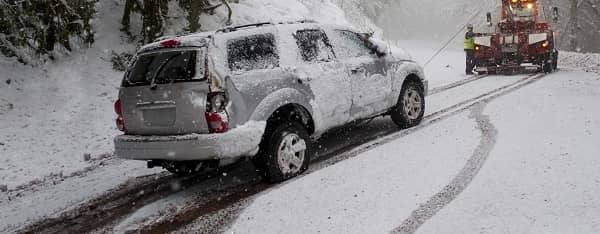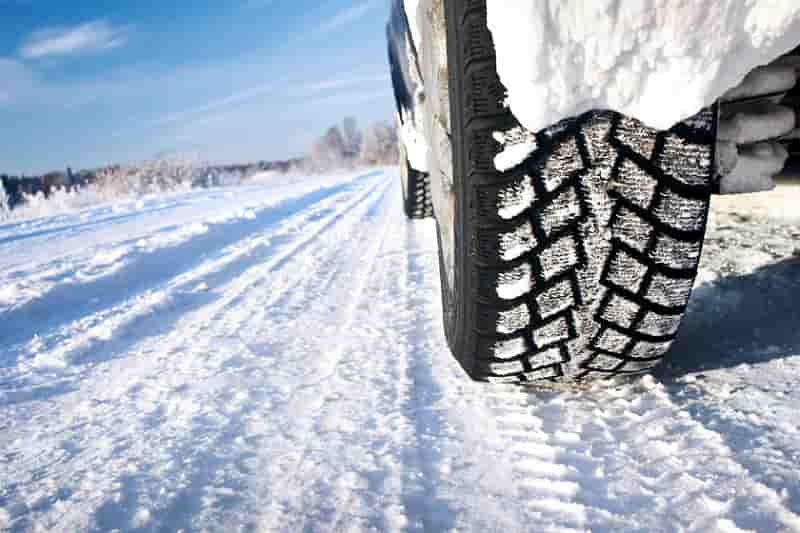Do My 4x4 Trucks Need Winter Tires? The answer is yes. On snow and slippery surfaces, even four-wheel-drive vehicles need winter tires.
Contents
Why Fit Winter Tires on a 4x4?
All-wheel drive vehicles must also be fitted with winter tires. The 4-wheel drive helps but has a different function than snow tires. In winter conditions, on snow, ice, and wet roads, only snow tires can guarantee safety and grip, especially when cornering and braking.
In these situations, especially downhill, a 4x4 is no more effective than a 4x2. Indeed, off-road vehicles are often heavier and more difficult to manage when braking and cornering.
It is crucial to fit winter tires on 4x4 vehicles. Only winter tires can guarantee the grip on snow, ice, and wet, thanks to the softer compound. The manufacturers offer maximum effectiveness with temperatures below 7 degrees Celsius.

It is crucial to fit winter tires on 4x4 vehicles
Which Winter Tires for a 4x4?
Almost all the major brands offer winter tire models for 4x4 vehicles that can offer greater braking effectiveness, traction, and resistance to aquaplaning. Designed specifically for the needs of off-road drivers in winter conditions, these tires have the following characteristics:
- Materials suitable for low temperatures
- Directional tread, often asymmetrical
- Deep grooves with many gripping edges
- Dense siping
- Wide longitudinal grooves
Should I Fit Two or Four Winter tires?
To save money, it may be tempting to fit only two winter tires. However, fitting only two winter tires is risky. A vehicle equipped with two winter tires and two summer tires can be dangerous as it creates an imbalance between the front and rear wheels with the risk of losing grip when cornering.
Depending on the position of the two winter tires, front or rear, the vehicle will have a tendency to oversteer or under-steer (rear or front end losing grip). Also, fitting only two winter tires on a 4x4 vehicle can damage the drivetrain.
Which 4x4 Tires to Choose?
Before buying a certain tire model, it is important to ask what we use the 4x4 for? Do you travel a lot on the motorway? Do you drive only in the city? Do you live in the countryside and work in the city? Do you go to the countryside on weekends?

Which winter tires to choose?
It is vital to establish the type of roads you usually travel on (urban roads, motorways, and dirt roads), your driving style, and the performance sought in a tire (durability, road holding, or rolling resistance).
The different tires for 4x4:
- H/T road tires: designed for mainly road use (city, suburban roads, and highways). These tires offer similar performance to passenger car tires but have a higher load index. They are designed for off-road driving only occasionally, on non-muddy and slightly uneven routes, at moderate speed (off-road use 20%).
- Mixed A/T tires: multipurpose tires designed for mixed-use on-road and off-road vehicles (50% off-road use).
- Green tires: tires with low rolling resistance that reduce fuel consumption and therefore CO2 emissions.
When choosing winter tires for a 4x4, it is vital to consider your daily needs and the weather you usually face. Do you live in the mountains, in the city or by the sea? What kind of climate characterizes your region? Do you often face snow, ice, and rain? Or do you live in an area with mild winters?
In temperate regions, all-season tires can be an affordable alternative. In regions where temperatures drop below freezing for many weeks. It will be necessary to fit winter tires that are mandatory in some countries.
All-Wheel Drive Vehicles and 4x4 Tires
In an all-wheel-drive vehicle (4WD and AWD), engine power is transmitted to each wheel independently. If one wheel spins, the others can continue to turn to ensure the vehicle has the traction to avoid getting stuck in the snow.
4x4s come with special transmission components, such as the differential and the Ferguson joint, that allow the wheels to turn at different speeds. However, if they are constantly stressed to handle different rotational speeds, it can cause premature wear of some mechanisms and irreversible damage to the transmission.
It happens when the off-road tires are not the same size because of different wear and therefore are constantly spinning at slightly different speeds. As mentioned, the transmission can withstand a slight difference between the two axles. But if the difference increases, the transmission can suffer.
There are two fundamental rules to be respected to preserve the transmission of a four-wheel-drive vehicle. To avoid damage to the transmission parts of a 4x4 vehicle, observe the following two rules:
- Always fit four identical tires on a 4x4 vehicle: same structure, same model, same size, same load and speed indices.
- Maintain even wear on all tires and replace them at the same time.
Conclusion
Does my 4x4 need winter tires? The choice of the most suitable 4x4 tires essentially depends on the type of 4x4 vehicle and the intended use. To choose the right tires, you must first consider the type of 4x4 vehicle.
I’m Ivo Gievski, the content writer for Tireer. We built our website with over 15 years of experience and extensive research in the automotive and technology sectors. My dedication to delivering high-quality content is unwavering, and I strive to continuously hone my skills to stay ahead of industry trends and provide readers with informative, engaging, and valuable insights.